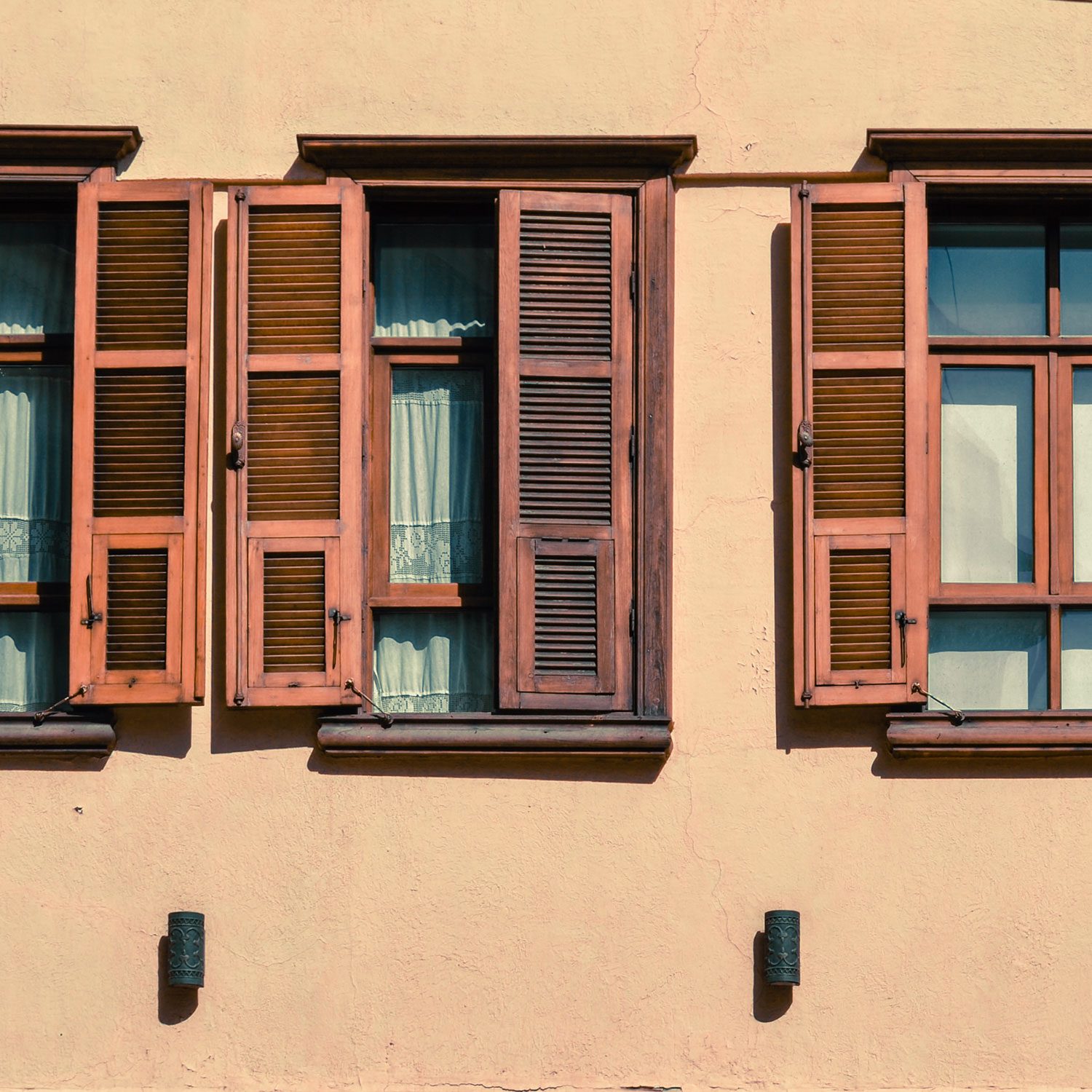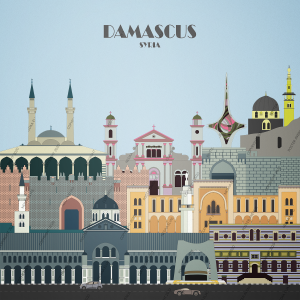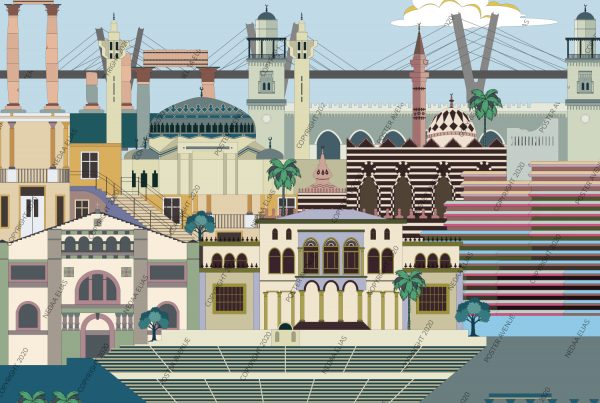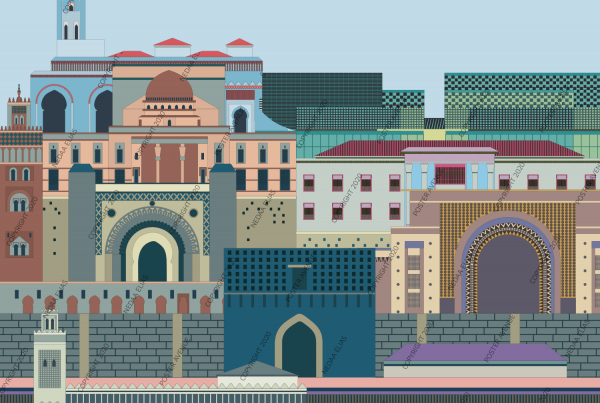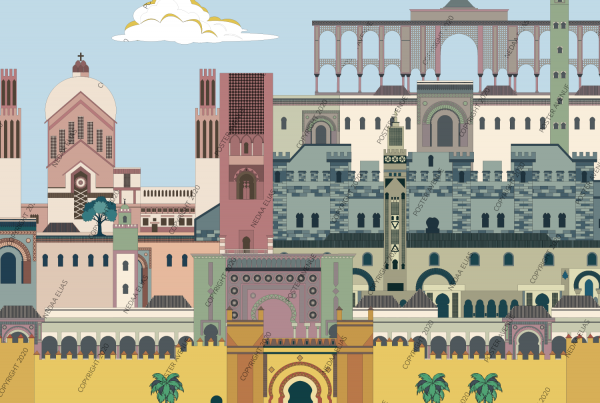Oldest capital and one of the oldest cities in history, Damascus holds diverse styles of architecture, stratified in layers. The city grew as a vital cultural and commercial center due to its geographical position between the orient and the occident. It is counted among the oldest continually inhabited cities in the world. The Ancient City of Damascus exhibits an outstanding universal value as it is listed under the UNESCO world heritage. The Greco–Roman influence is seen in the city’s urban planning, as it features a north-south or east-west orientation. During the Islamic prevalence, the city was made the capital of the Umayyad caliphate, paving the way for an exceptional flourishing. The layout of the old city also contains the Islamic pattern, known for the narrow and organic alleys. The stratification is visible in this overlapping between the Greco-Roman and the Islamic urban planning of Damascus.
The historic city is surrounded by a defensive wall and seven surviving gates. Bab Touma, also known as the “Gate of Thomas”, is a geographic landmark of Early Christianity. It was named in commemoration of Saint Thomas the Apostle. The current visible structure is the result of its reconstruction during the 13th century by the Ayyubid dynasty. On the other side of the walled city, stands the great Citadel of Damascus. Initially erected in the 10th century by the Turkman Atsiz bin Uvak, it stands as a well-established medieval fortification at the entrance of the ancient city of Damascus. The emirs of the subsequent dynasties performed several modifications and additions to the structure. However, in the 13th century, the structure was completely rebuilt under the rule of the Ayyubid dynasty to reach its current profile. The citadel is distinctive by being one of the few castles erected on flat ground at the same level as the rest of the city. The citadel encompasses 12 watchtowers, topped by a double parapet, and armed with corner machicolations and numerous arrow slits as defensive features.
Just in front of the Citadel, and outside the city walls, an outstanding Islamic institutional structure fulfills the function of justice and Islamic ruling since the 12th century onwards. The Palace of Justice or Dar al-Adl features a Moorish architecture style with its monumental multifoil arch entrance, exquisite adornment crowning the slender windows, and the triplet window above the entrance door.

Inside the city walls, stands the largest and most outstanding mosques of the Umayyad caliphate. The Umayyad Mosque or the Great Mosque of Damascus was built in 634 after the Muslim conquest of Damascus. The structure has a rectangular plan with a central courtyard positioned at the Northern side, surrounded by a series of arcades. The arcades consist of two levels, on the ground the large semi-circular arches separated by marble piers, and on top the double-arched windows. The mosque has three domes, with the main one known as the “Dome of the Eagle”, it rests on an octagonal substructure over the main prayer hall. The court façade is notable by a monumental gabled entrance in the middle, which depicts a Byzantine influence with its glass and gold-leaf mosaics. The complex is distinctive by three referential minarets: Minaret of Jesus on the southeast corner, Minaret of Qaitbay on the southwest corner, and Minaret of the Bride in the middle of the northern wall.

Just adjacent to the Umayyad Mosque, the shrine of the Ayyubid Sultan Saladin is located. The Mausoleum of Saladin reflects a typical Damascene construction, with a square chamber surrounded by four arches transitioning into a ribbed cupola via intermediate drum. Another admirable example of Damascene’s traditional construction is the 18th century Azem Palace. Located within the ancient city walls, the private residence for the governor of Damascus showcases an alternating course of white limestone and black basalt. Composed of three wings, the harem, the selamlik, and the khademlek, the building’s interiors and the exterior exquisite stonework details demonstrate the excellent masonry craftsmanship of Damascus. Similarly, the Tekkiye Mosque or Hospice Sulaymaniyah represents the finest example of Ottoman architecture in Damascus. The complex contains Ottoman features such as the pencil-like minarets and the cascading domes, complemented by a Damascene essence with the alternating light and dark stripes.
The richness of the architectural scene in Damascus is not limited to the historic city, the modern city is a complete contrast as well. The streets are organized according to a western grid system and the buildings have a simple composition yet modern structure. A more European architectural style can be noted in the Holy Cross Church, with its twin belltowers, central pediment, ionic order columns, and twisting elements, all achieving a superb contrast between light and shadow.

Moreover, a revival of Islamic architecture is represented with the Unknown Soldier Monument. After winning a competition organized by the Syrian Ministry of Defense, the monument was erected in 1985 as a war memorial to commemorate the deceased Syrian soldiers. The structure is composed of an immense dome, epitomizing the universe, contained within a pointed arch, implying victory. Verses from the Quran are inscribed into the structure within a green belt. Likewise, the Damascene Sword Monument is a symbol of the power and glory of Syrian civilization. It is positioned in the middle of the Umayyad square, an intersection of major highways, which connects important edifices of the city. The monument features a large iron sword structure originally encompassing the flags of participant countries in the Damascus International Fair. Later, when the Fair moved to a new location, the sword was ornamented with a stained-glass abstract geometry, expressing a fusion of the fire and the rose.
Damascus attests to the unique aesthetic achievement of the civilizations which shaped it. Its major monuments of different periods are a living testimonial of that achievement. Being the capital of the first Islamic caliphate, the city has influenced the advancement of subsequent Islamic cities. The city was and continues to be associated with important historical events, thus the narration of its urban memory is in constant evolvement.



